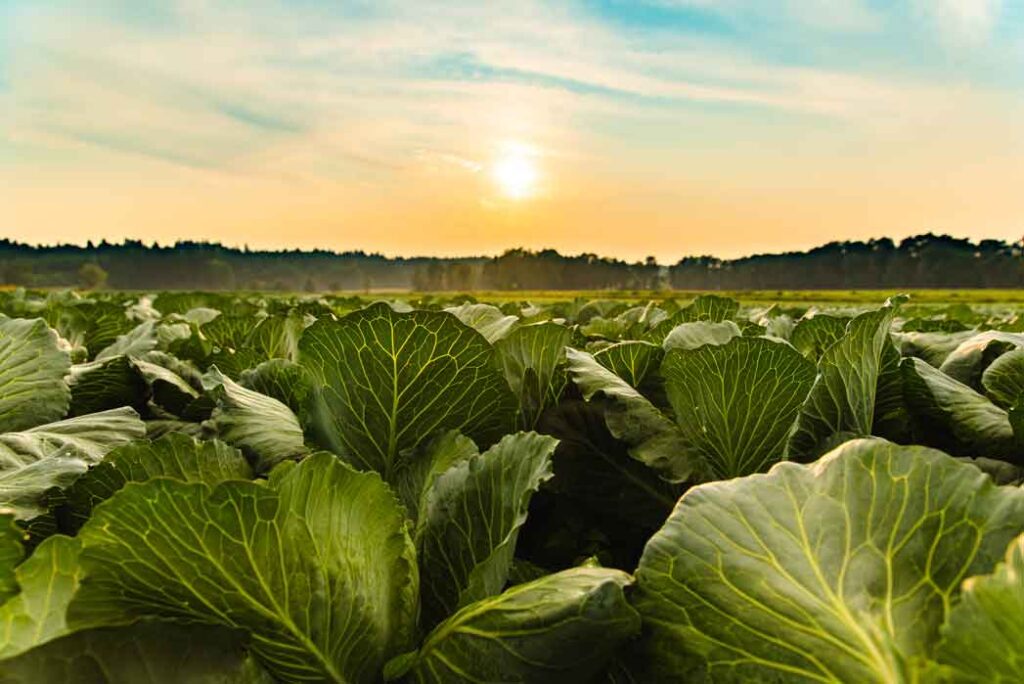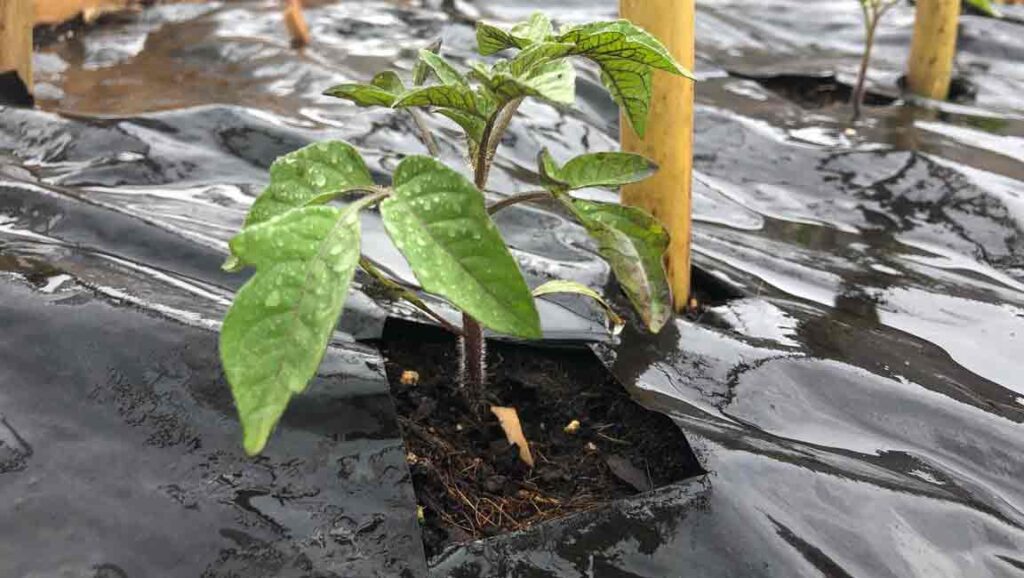Planting cabbage is one of the oldest agricultural practices we know of, and one that has accompanied us throughout history. A vegetable that originally appeared in the wild, today has evolved into multiple varieties, some more resistant than others to climatic and thermal factors, but with high nutritional value and excellent adaptability to be grown in different environments.
This vegetable is part of the Brassicaceae family and offers a wide range of possibilities for those of us who plan productive and sustainable crops on our agricultural roadmaps. Welcome once again to our Novamulch agricultural space. Let’s study.
Ancestral origin and historical background of cabbages.
Since their first appearances in the wild thousands of years ago, cabbages were cultivated and gradually domesticated from the Neolithic period onwards, reaching northern and northwestern Europe and Western Asia throughout the regions of the Fertile Crescent (present-day Iran, Iraq, Syria, Palestine, Israel, Egypt, Lebanon and Anatolia, present-day Turkey), where agriculture, livestock farming and the settlement of villages began to be practiced, leaving their traces stamped on megalithic structures, pottery fragments and agricultural remains.
Records of the harvesting and cultivation of primitive cabbage varieties have been found in the Mediterranean and in vestiges of the Minoan, Mycenaean, and later Greek civilizations. Around the 4th century BC, texts by Theophrastus, considered the first botanist in history, already documented different types of cabbage cultivated in Greece and prized for their nutritional and medicinal properties. These plants were known as krambē (κράμβη) in ancient Greek.
This background shows us the historical epicenter of cabbage cultivation in these key areas for the transition from wild plants to domesticated crops during the agricultural Neolithic.
The first systematic record of cabbage cultivation comes from Theophrastus, a Greek philosopher and botanist of the 4th century BC, in his work Historia Plantarum.
Theophrastus describes cabbages as plants resistant to low temperatures, cultivated for their edible leaves, and identifies varieties with smooth and curly leaves and therapeutic properties.
Hippocrates, the father of medicine, recommended its consumption to aid digestion and treat gastrointestinal diseases. Even in the classical Greek diet, it was common to boil cabbage leaves and eat them seasoned with olive oil.
In Rome, cabbage cultivation achieved remarkable expansion and diversified into several local varieties.
In the 2nd century BC, in his treatise De Agri Cultura, Cato the Elder makes complimentary references to cabbages for their medicinal virtues and their use as anti-inflammatory and detoxifying agents. He also notes the practice of planting cabbages as highly valued and common in family gardens and rural villas, especially in Lazio and Campania.
Around the 1st century BC, Pliny the Elder described around 7 varieties of cabbage in his “Natural History”, which he identified by their shape, size, flavor, and their nutritional and medicinal properties, which indicates the advancement of selection of these vegetables at that time.
Cabbage was grown in the fall and winter, and both Greeks and Romans made seedbeds for later transplanting into the final soil. They used manure as an organic fertilizer and favored growing in fertile, well-drained soils. The Roman hortus, or garden, was attached to urban and rural areas and was considered essential to everyday domestic life.
After the fall of the Roman Empire, thanks to religious orders such as the Benedictines, many agricultural practices such as planting cabbage continued in monasteries, and these monks passed on the existing farming techniques and agricultural knowledge.
Furthermore, the Capitulare de Villis issued by Emperor Charlemagne (9th century), one of the medieval manuscripts on agriculture, specifically refers to “brassica” as one of the vegetables that were required to be grown in the imperial lands.
During the Middle Ages, planting cabbage became a well-established and widespread activity in monastic and peasant gardens throughout Europe, as it adapted easily to temperate climates and was resistant to low temperatures. During this period and in the northern regions of Europe, a wide variety of curly cabbages such as kale was developed, and throughout the more temperate regions, the red cabbage variety became popular, as did cabbages, which were very suitable for winter storage.
Between the 10th and 14th centuries, cabbage cultivation spread and became popular in the Netherlands and Scandinavia, and the production of varieties such as kale improved throughout the Germanic and Nordic regions, as well as compact-headed cabbages in the western Mediterranean.
This was due to the growth of villages and rural markets, the implementation of crop rotation that allowed for greater horticultural diversification, the excellent response to planting cabbages in fertile, moist soils and in temperate and cold climates, and the adaptation of existing varieties.
By the 16th century, Spanish and Portuguese settlers brought cabbage seeds to America, along with onion, garlic, lettuce, and carrot seeds.
The first records of cabbage cultivation in the New World are found in the Caribbean and Mesoamerica, where cabbage seeds were planted in convent gardens and colonial farms. Later, cabbage cultivation expanded to the high Andes, the Mexican plateau, and the territories of the Viceroyalty of Peru, where the temperate, cool climate was conducive to its development.
In North America, cabbages were introduced by English and Dutch settlers during the 17th century, quickly becoming established in the gardens of New England and New Amsterdam (present-day New York), where the climate was similar to that of Europe.
Cabbage planting was an agricultural activity that was favorably integrated into local systems, due to its high adaptability to different soil types, its easy tolerance to low temperatures, and its excellent cultivation in high-altitude regions.
Today, cabbage varieties include not only collards or cabbages, but also cauliflower, broccoli, Brussels sprouts, Romanesco, and other varieties that have diversified through agronomic improvements and new technologies.
This link will interest us:
https://es.wikipedia.org/wiki/Brassica\_oleracea\_var.\_capitata
To plant cabbages we need to study their morphological characteristics.
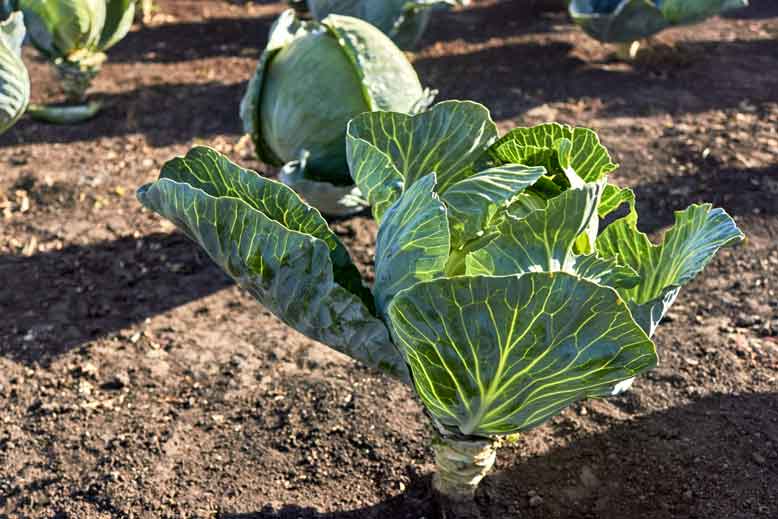
Cabbages are vegetables grown specifically for their edible part, which we know as the head or bud, made up of leaves that curl around each other.
It is composed of a thick, vertical main root, from which secondary or lateral roots are generated. This structure allows for good anchoring to the ground and good absorption of water and nutrients into the deep layers of the soil. Therefore, planting cabbages in compacted soil or with poor drainage capacity is one of the aspects we should avoid.
The cabbage stem is very short and almost invisible, as it is almost completely covered by the leaves. All the leaves are arranged around the stem in a rosette with a waxy surface that reduces water loss and serves as a protective shield against pathogens and adverse environmental conditions, such as wind or intense sunlight. The head or bud develops in the center of this leaf system.
If the sprouts are not harvested, they will form yellow flowers with four petals at the top, and we call this stage heading. At this point, we won’t harvest a crop, but we will obtain rounded seeds inside the fruit (silicua), which is an elongated capsule containing these seeds.
How to plant cabbage in different environments?
Including cabbage cultivation in our agricultural roadmap offers us a great opportunity to obtain high-quality and profitable harvests. These vegetables have varied cycles and adapt very well to temperate, humid, mid-altitude temperatures. This gives us the freedom to plant them in the environments available to us, whether in open fields and large areas or in smaller spaces such as home gardens and greenhouses. Let’s study.
Planting cabbages in open field.
Necessary climatic requirements.
As we’ve already seen, our cabbages are vegetables that are easily grown in temperate climates and thrive in cool areas with good humidity levels. Their adaptation to open fields will depend on the following factors:
Temperature.
Ideal growing conditions range from 15° to 20°C. If cabbage is planted in other thermal conditions, such as below 10°C, vegetative development will be very slow, and the crop may be affected.
If we manage to achieve a good vegetative stage (first stage of development), cabbages can withstand light frosts down to -3°C or -4°C; this is only possible if we have produced high-quality substrate and soil preparation, certified seeds, or robust seedlings.
If, on the other hand, our thermal conditions exceed 25°C, we are highly likely to affect the formation and harmonious development of the plant’s structure.
Sunlight and Winds.
It is recommended to plant cabbages in areas that receive a minimum of 6 hours of direct sunlight to allow adequate formation of leaf biomass and a compact, firm head.
Likewise, in these large environments, we run the risk of experiencing dry winds or intense low temperatures, which can cause leaf dehydration or cracking. In these cases, it is important to install natural windbreaks or netting in areas prone to these events, especially during the transplant and head or bud formation stages.
Rain and Humidity.
It’s recommended that we achieve a moderate and balanced humidity level from the start of the crop. Here, we should use biodegradable paper mulch to avoid potential problems, especially during the vegetative growth of our cabbages.
Remember that excess humidity and frequent rainfall, which can cause excesses such as waterlogging or leaching, will promote the development of diseases such as botrytis, as we will analyze later.
Proper soil preparation and nutrition for planting cabbage in open fields.
Let’s watch this video on planting organic cabbage in the open field. Fun fact: Novamulch biodegradable paper mulch saves us from manually removing weeds. We’ll also see some pests and diseases in action, sprayed with potassium soap.
And here we share another very entertaining video about planting cabbages in open fields on ridges with a drip irrigation system:
Soil preparation:
For these crop sizes, we need to till deeply, approximately 25 to 30 cm, to break up compacted soil such as solid clods and stones that could hinder subsequent tilling or the root development of the cabbages, as they require soil with good drainage and aeration capacity.
If your soil is heavy or unlikely to drain properly, we recommend creating raised beds or ridges of 15 to 25 cm to facilitate water flow and achieve a smooth circulation of both water and oxygen, especially for the roots.
Before planting cabbages, we’ll analyze the soil structure we have for our agricultural project.
Let’s take pH measurements, which should range between 6.0 and 6.8. More acidic soils are prone to cabbage root rot, and to counteract this, we’ll use liming. This is a common practice for soils with low pH (acidic), which makes it difficult for plants to absorb nutrients and paves the way for diseases such as cabbage root rot.
For this, we will add Calcium Carbonate (CaCO₃): ground limestone or agricultural lime, Calcium oxide (CaO): quicklime, calcium hydroxide (Ca(OH)₂: slaked lime, and Dolomite: a mixture of calcium and magnesium carbonate (CaMg(CO₃)₂).
To promote moisture retention and microbial development, it is necessary to include organic matter, as well as Nitrogen (N), Phosphorus (P₂O₅) and Potassium (K₂O), which are essential nutrients for balanced development.
Thirty days after completing this preliminary phase, we’ll repeat the measurements and, if necessary, evaluate another amendment to reinforce the effect. Remember, we’ll do all of this before transplanting our cabbages.
Once this preliminary preparation step is complete, it is important to consider using Novamulch biodegradable paper mulch to ensure:
- A balance of moisture levels throughout the planting cycle.
- Avoid the appearance and proliferation of weeds and fungi, as well as direct contact of our cabbages with the soil.
- Paper mulch prevents deterioration or rotting of the stem, leaves, and fruits of our crops.
Soil nutrition:
Let’s always keep in mind that planting cabbages on organic surfaces and in organic environments will provide more benefits for our health and for the health of the ecosystem.
So let’s analyze below some organic fertilizers that work very well for us:
Well-composted manure:
It provides nitrogen, phosphorus, potassium, and organic matter. It must be applied completely decomposed, dry, and loose to avoid health problems or fermentation during our crops.
Mature compost:
It helps enrich and improve soil structure. It can be added before transplanting or as a top layer during planting.
This involves the controlled decomposition of plant waste, and it is considered mature when it has completed all the steps of the composting process. This means that the material has reached a level of equilibrium such that at any given time it should not generate heat or fermentation, and should present an appearance and smell similar to forest soil.
Let’s pause and study how to make mature vegetable compost to plant cabbages in a healthy and productive ecological environment:
Gather and mix:
- Carbon-rich materials.
- Dry leaves.
- Crushed branches.
- Cardboard or paper without ink.
- Straw or sawdust (in small quantities).
Nitrogen-rich materials (green matter):
- Fruit and vegetable scraps.
- Freshly cut grass.
- Young weeds (without seeds).
- Vegetable kitchen scraps (without fat or salt).
An approximate ratio between these two nutrients can be 25% Carbon to 30% Nitrogen.
Compost bin base:
Use a container with holes in the bottom to allow for proper drainage, or use a pallet crate or a pile on solid ground.
Place woody material on the bottom to promote aeration and drainage.
Stack in alternating layers:
Dry layers (carbon) and green layers (nitrogen).
The layers should be kept moist (like a wrung-out sponge).
Avoid compacting our material.
Temperature control:
The pile should be heated in the first few days (thermophilic phase), between 55° and 65°C.
High temperatures destroy pathogens and seeds.
If we notice that the temperature doesn’t rise, it’s likely due to a lack of nitrogen, moisture, or aeration.
Stir and aerate regularly:
Stir and turn the pile every 7 to 15 days during the first few weeks. This allows the mixture to oxygenate and speed up the process. If you notice an unpleasant odor, it’s likely due to excess moisture or compaction of the material.
Maintaining the right humidity:
The correct humidity ranges from 50% to 60%, and we check if a drop of water comes out when we squeeze a handful. If it’s dry, we’ll add water or green material; if it’s wetter than expected, we’ll add straw or shredded cardboard.
Maturity Time:
Our compost will be mature when it shows the following signs:
A damp earthy smell.
We cannot recognize the original additions.
Its temperature is equal to that of the environment.
It has acquired a lumpy, dark texture.
Estimated maturation times:
Short, estimated time between 4 and 6 weeks, if we turn frequently and balance the carbon and nitrogen levels.
Slow, estimated time between 3 and 6 months, if we don’t intervene in the composting process.
How do we check if our cabbage composting material is mature?
Place a small portion of the material in a bag, seal it, and keep it there for 3 days. After this time, open the bag and you should notice the scent of forest soil; this means it’s ripe and ready to be added to your crop.
Another way to check the maturity of the material is to make a seedbed with a mixture of compost and soil. If we observe proper, fluid germination, we have mature compost.
Complementary ecological amendments for planting cabbages in sustainable environments:
Rock or basalt flour.
It provides micronutrients such as magnesium, silicon, and iron. It improves the soil’s natural properties to withstand sudden pH changes when acids or bases such as fertilizers, organic matter, and lime are added.
Worm castings.
This is a rich and balanced source of slow-release nutrients. It improves soil conditions and water retention capacity.
Untreated wood ash.
Very rich in potassium, calcium, and trace elements, it can be added with caution to acidic soils (to avoid over-alkalizing).
Natural biostimulants.
We can apply seaweed extract, aerated compost tea, fermented nettles, and comfrey as foliar supplements or through fertigation to stimulate both plant growth and flowering, or to strengthen the immune system of our vegetables.
Nutrient replenishment and crop rotation.
Planting cabbages requires high levels of nitrogen and potassium, so it’s a good idea to rotate with legumes like broad beans and peas to fix nitrogen, alternating with non-cruciferous root crops like yellow, white, or purple carrots, beets, radishes, parsnips, and celeriac to reduce soil depletion and pathogen buildup.
This interesting video shows us another way to grow. Enjoy!
Which cabbage varieties are suitable for growing outdoors?
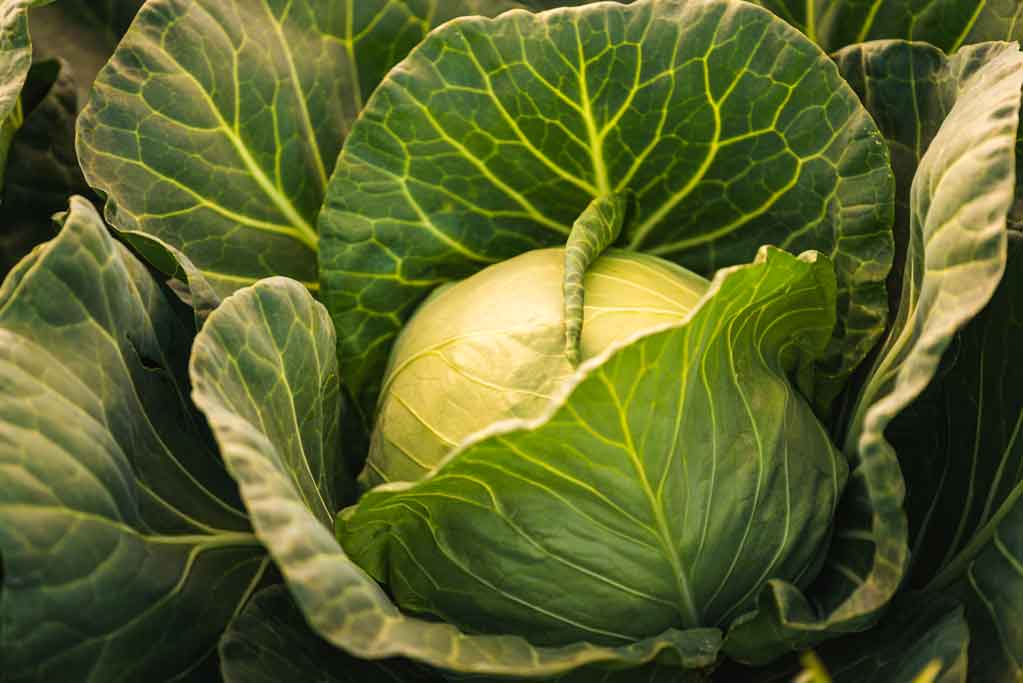
Green smooth-headed cabbage.
Featured varieties:
Brunswick.
This is a traditional cabbage variety with a smooth, green head, well known for its resistance to low temperatures and its good adaptation to open-field cultivation. It is one of the oldest varieties still cultivated due to its reliability and effective yield.
Main features and benefits of planting Brunswick cabbage:
- Medium-long cycle, it is usually ready for harvest between 90 and 100 days after transplanting, but prior planning is necessary for planting.
- Large, compact head, rounded or flattened shape, with thick green outer leaves.
- Approximate weight of 2 to 4 kg per head.
- Resistant to low temperatures, it is ideal for late summer or autumn sowing, as it tolerates cold winter periods well.
- It is an open-pollinated variety, so its seeds can be collected for future planting, a value highly prized in organic farming.
- These vegetables adapt easily to different types of soil as long as we fertilize them properly.
- It is an excellent option for organic farming and for home and urban gardens.
- Suitable for fermentation in the preparation of sauerkraut and for storing fresh.
Kilaton F1.
This is a hybrid cabbage with a smooth, green head that is especially resistant to common soil-borne diseases, making it a very safe choice for open-field cultivation. It is a high-yielding variety commonly grown in both conventional and organic farming.
Main features and advantages of planting Kilaton F1 cabbages:
- F1 hybrid, meaning it has been genetically improved through selected crosses to offer greater yield and uniformity.
- High resistance to cabbage leaf spot (Plasmodiophora brassicae): one of the most serious diseases affecting cruciferous vegetables.
- Medium cycle, usually ready for harvest 80 to 90 days after transplant.
- Firm and rounded head, weighing between 1.5 and 3 kg, very compact, excellent presentation.
- It requires good drainage and crop rotation for optimal development.
- Seeds cannot be reused for future crops.
- Suitable for growing in areas with a history of soil diseases.
- It produces homogeneous crops that are easy to harvest, whether manually or mechanically.
- Good shelf life after harvesting.
Candela F1.
This hybrid cabbage variety is specially designed for fast harvests, with high-quality heads and excellent performance in open fields. It is very popular for its short cycle and heat tolerance, making it perfect for spring and summer plantings.
Main features and advantages of planting Candela F1 cabbage:
- F1 hybrid, that is, this is a genetic improvement that guarantees uniformity and high yield, but due to its hybrid nature, the seeds cannot be reused.
- It requires good irrigation and nutrition control to reach its full potential.
- Short cycle, ready to harvest between 65 and 75 days after transplant.
- Compact and round head with average weight between 1.2 and 2 kg.
- Smooth, green leaves with a fine texture, highly appreciated in the fresh market.
- Excellent option for intensive crops with several rotations per year.
- Since this variety is resistant to high temperatures without losing its quality, we can plant them in warm seasons.
- Good resistance to cracking if these cabbages are opened prematurely.
- They adapt very well to different types of soil as long as we have fertilized them properly.
Red cabbage.
Featured varieties:
Rodima F1.
A hybrid with a deep, glossy, dark purple color, a compact, round, and firm head, weighing between 1.5 and 2.5 kg per head. With a medium growing season, it can be harvested between 85 and 95 days after transplanting and produces uniform plants highly prized in fresh markets for their impeccable presentation and excellent post-harvest shelf life.
Main features and advantages of planting Rodima F1 cabbage:
- High resistance to cracking, even under heavy rain or after abundant watering.
- Excellent resistance to premature bolting and good post-harvest preservation, making this variety very effective for transport and storage.
- It adapts well to different climatic conditions.
- Good tolerance to common cruciferous diseases.
- Very suitable for planting in spring and summer, and harvesting in summer and autumn.
- It resists light frosts at the end of its cycle, and therefore late harvests can be made.
- It requires well-drained soils, rich in organic matter and with a pH between 6.0 and 7.0.
Langedijker Rood.
This is a traditional, non-hybrid red cabbage suitable for planting in home and urban gardens, as well as in organic and conservation agriculture. Native to the Netherlands, it adapts easily to low temperatures, making it an excellent choice for harvesting in autumn and winter.
Main features and advantages of planting Langedijker Rood cabbages:
- Its growing cycle ranges from 100 to 120 days from transplant.
- Compact, large head, rounded to slightly flattened.
- Average weight between 2 and 3.5 kg per mature head.
- Firm and crispy texture, very suitable for fresh cutting or preserving.
- Sweeter flavor than other purple cabbages, especially after a light frost.
- It requires prior planning in the planting calendar.
- It requires loamy, well-fertilized soils with a pH between 6.0 and 7.0, and can be sensitive to
- to water stress or poor soils if not enriched with compost.
Integro F1.
Integro F1 is a hybrid variety of red cabbage, developed by the Bejo Zaden nursery and specifically designed for planting in open fields during the summer and fall cycles. It has established itself as one of the most widely cultivated red cabbages in Europe due to its uniformity and excellent commercial presentation, and is in high demand in professional export agriculture.
Main features and advantages of planting Integro F1 cabbages:
- It is an F1 hybrid (certified seed of high genetic purity), its average crop cycle is between 80 and 90 days after transplant, its head is compact, round, very firm with an average weight of 1.2 to 2.5 kg, smooth leaves, well wrapped, with excellent leaf coverage and a sweet and mild flavor, recommended for consumption fresh or cooked.
- Integro F1 produces very uniform plants with high visual quality thanks to its intense, glossy purple-red color, compact shape, and firm texture. It is ideal for the fresh market, both in whole pieces and grated. It has a good shelf life after harvest, maintaining firmness and color in cold storage.
- It adapts to a variety of well-drained, loamy or clayey soils, well aerated with a pH of 6.5 to 7.2, and responds well to late spring and mid-summer planting schedules, with harvests that can extend well into the cold season.
Kale.
Featured varieties:
Nero di Toscana (Tuscan or dinosaur kale).
Also known as Tuscan kale, it is an ancient, non-hybrid variety highly valued in sustainable horticulture and widely cultivated in Italy for centuries, especially in the Tuscany region, where it takes its name.
Main features and advantages of planting Nero di Toscana cabbage:
- Its medium to long crop cycle is between 70 to 90 days from transplant.
- With dark, long, narrow leaves, quite wrinkled and dark green, almost black, tender texture when cooked and firm when fresh, with a mild flavor, less bitter than other varieties of kale, it grows vertically without forming a head.
- Very resistant to low temperatures and light and moderate frosts, it allows continuous leaf-to-leaf harvests for several weeks or months, which prolongs production without the need for replanting. It grows well in varied soils provided they have good drainage capacity and sufficient organic matter, with a pH between 6.0 and 7.2.
- It is resistant to pests and diseases, and is recommended for organic farming and systems without intensive treatments.
- It doesn’t require training or complex pruning techniques. Its upright structure makes it easy to manage in the field. Rich in vitamins C, K, iron, calcium, and antioxidants, it is highly valued in healthy cooking and green juices.
Westlandse Winter.
Also native to the Netherlands, this variety is typical of the intensive horticulture of the Westland region and has been specifically bred to withstand harsh winter conditions, making it an ideal choice for open-field cultivation during the coldest months of the year. Westlandse Winter cabbages are commonly planted both in open fields and in home and urban gardens, in organic farming and self-sufficiency systems, due to their high nutritional value (rich in nutrients and antioxidants), climate tolerance (it withstands severe frosts without protection), and long harvest duration.
Main features and advantages of planting Westlandse Winter cabbage:
- Its growing season is long, between 100 and 120 days from sowing, or 70 to 90 days from transplant. It is an upright plant without head formation, with curly, broad, dark green to blue-green leaves and a mild, sweet flavor, especially after frost.
- It can be harvested leaf by leaf continuously for 4 to 6 months, ensuring a constant supply and reducing the need for replanting.
- After harvesting, the leaves will stay fresh in refrigeration for up to a week, and can also be blanched and frozen for longer use.
- It is sown in late summer or early fall and will thrive well into the following spring, even in temperate to cold climates.
- It is fairly tolerant of common cruciferous diseases, especially if rotated properly.
- As it is a traditional variety, we have the possibility of reserving its seeds for future crops.
Redbor F1.
This hybrid kale variety is characterized by its dark purple color and elegant curly appearance. It was developed to combine nutritional value (rich in nutrients such as vitamins A, K, C, and antioxidants), commercial performance (widely accepted in gourmet and organic markets and very popular as an edible decorative element), and visual appeal, making it suitable for both food consumption and ornamental uses. Its medium cycle and cold resistance make it ideal for open-field fall and winter crops.
Main features and advantages of planting Redbor F1 cabbage:
- Its growing cycle is medium, between 80 and 90 days after transplant. Its leaves are very curly and firm with a crisp texture. It can reach a height of up to 90 and 100 cm vertically, and this cabbage variety tolerates low temperatures and moderate frosts very well, maintaining its structure and flavor.
- It can also be harvested leaf by leaf over several weeks or months without replanting, making it well-suited to staggered harvesting or microgreen production if harvested young.
- It requires well-drained soils rich in organic matter and a pH between 6.0 and 7.2. It requires regular watering to avoid waterlogging.
Planting cabbages in urban and home gardens.
Necessary climatic requirements.
The most favorable temperature for our cabbage planting project to develop successfully and with high quality ranges between 15° and 20°C, especially if we control these levels during the first phase: vegetative growth.
The maximum tolerable temperature will be 27°C or 28°C. In these cases, there is a high probability of water stress, and cabbage leaves and heads will establish with much lower quality. If the growing habitat exceeds 30°C, we increase the risk of pests such as aphids and whiteflies, inhibit head formation, and promote premature bolting or flowering. To address or minimize these conditions, we should install shade nets or choose cabbage varieties that are resistant to high temperatures.
On the other hand, the minimum tolerance our cabbages can withstand once this first stage begins is down to -5°C, especially for hardy varieties like kale. Adequate exposure to direct sunlight is between 5 and 6 hours daily. In warm climates, we can plant cabbages in areas with light, partial shade.
The recommended humidity levels for this crop are moderate, between 60% and 70%. However, if our climate is dry, it is very important to use biodegradable paper mulch to maintain stable humidity levels and prevent waterlogging. It is also important to install drip irrigation systems directed toward the soil rather than the stems and leaves.
It’s a good idea to group plants together in containers to create a more humid microclimate, but also to consider the compatible combinations we’ll explore later, so they don’t compete for essential elements like growth space, nutrients, air, and water.
If strong drafts or dry spells occur in our growing area that could break leaves or dehydrate the crops, we will install windbreaks made of permeable materials such as hemp, shade mesh, or trellises, and our containers or trays should be sheltered but with the necessary sunlight.
Proper soil preparation and nutrition for planting cabbages in urban and home gardens.
Unlike growing cabbage in open fields, in these urban and domestic environments we work with contained soils, so we must carefully study the structure of the soil we are going to create from the beginning.
We present two options. Let’s review them.
Plant cabbages in direct soil.
Step 1: If we are going to plant in gardens or soil patios, we must remove the soil to a minimum depth of 30 to 40 cm, breaking up compact layers, removing stones, clods or solid blocks, roots, plastic, metal or iron remnants (nails, screws).
Step 2: We add organic matter (which we have previously described in this agricultural space) to begin nourishing the worked surface, improving its texture and adapting it to achieve adequate aeration and drainage capacity.
Planting cabbages in containers.
Step 1: These containers should be at least 30 to 40 cm deep. We must examine the base of each one to determine if it has enough holes to allow proper drainage throughout the planting process.
Step 2: We place a layer of gravel or expanded clay at the bottom of each container, and continue with the previously prepared soil material.
Proper nutrition for mixing soil or containers:
We need to have on hand mature vegetable compost, natural garden soil previously sifted (passed through a mesh or sieve), to eliminate all residues, and it must be loose and aerated (this sifted soil is an excellent base to use as a pillar of mixing the rest of the nutrients that we are going to add), coconut fiber or worm humus, perlite, washed sand or vermiculite, well composted manure, crumbled, dry and loose.
This video illustrates very well the process of planting cabbage in small spaces:
Which cabbage varieties are suitable for growing in urban and home gardens?
In this agricultural study, we analyzed the Candela F1, Nero di Toscana, and Redbor F1 varieties. Let’s analyze the following cabbage varieties suitable for planting in these smaller spaces. Let’s see.
Minicole (F1).
Main features and advantages of planting Minicole (F1) cabbages.
- This is a hybrid variety of cabbage, or compact heart cabbage, developed for markets demanding smaller cabbages, suitable for unit sales and for home gardens, intensive crops, and organic production under controlled management.
- Its main advantage lies in its small size, uniformity and rapid development.
- From green to dark green, its growing cycle is between 60 and 70 days from transplant, and its weight is between 0.8 and 1.2 kg.
- It adapts very well to both open fields and greenhouses, as well as urban and domestic gardens.
Golden Acre.
Main features and benefits of planting Golden Acre cabbage.
- Traditional variety of heart-shaped cabbage, or round and slightly pointed.
- Its cycle is early and can be harvested 60 to 75 days after transplanting. It weighs between 1.2 and 2.0 kg, is light green in color, with tender, smooth outer leaves, and is compact in size with a mild, sweet flavor.
- Well known for its adaptability and tolerance to low temperatures.
- It’s ideal for growing in urban and home gardens, as well as for small-scale production. However, it has been used in professional agriculture for decades due to its efficient profitability.
Kalibos (pointed red cabbage).
Main features and advantages of planting Kalibos cabbages.
- A conical variety of red cabbage, also known as pointed red cabbage, which stands out for its intense purple-violet color, tender texture, and sweet, mild flavor.
- It is ideal for both home gardens and professional open-field crops, especially in organic farming systems.
- Its growing cycle is between 75 and 95 days from transplant, its weight is between 1.0 and 2.0 kg, with a sweet and mild flavor and less acidic than other varieties.
- Very suitable for planting between autumn and winter. Its compact and moderate size makes it suitable for medium-sized plantings.
Planting cabbages in greenhouses.
Necessary climatic requirements.
These environments are perhaps the most suitable for planting cabbages, as they allow us to maintain climate control and create microclimates based on temperature requirements (between 15° and 20°C), ventilation, which must be continuous and sufficient to avoid excessive humidity, exposure to natural sunlight for a minimum of 6 hours daily, and continuous but not excessive irrigation.
In these cases, biodegradable paper mulch serves a complete purpose in the growing cycle of our cabbages, covering all the essential needs for optimal results and high-quality fruit.
Proper soil preparation and nutrition for planting cabbage in greenhouses.
In greenhouses, we must ensure that the soil has a loose structure, with good drainage capacity and depth so that the cabbage roots have the opportunity to penetrate the soil and strengthen easily.
For this, it will be necessary to till the soil to a depth of between 25 and 30 cm. We will prepare a loamy or sandy loam soil, which is ideal for good drainage and anchorage.
We remove remnants of solid, hard material such as compacted clods and stones, as well as any traces of previous planting to avoid possible contamination, and level the surface.
This is when we can spread the biodegradable paper mulch, in which we will make holes respecting the recommended distances to place each cabbage seedling.
What nutrients should we add to the soil when planting cabbages?
As we’ve already discussed in this agricultural section, we must first have the essential supplements on hand to complete soil preparation, combine them, and perform pH measurements (between 6.2 and 6.8).
If we find we need to make any amendments, let’s take advantage of this time before planting begins to close this previous chapter of our agricultural plan. Let’s review the analysis we did earlier on proper soil nutrition for planting cabbages.
What cabbage varieties are suitable for growing in greenhouses?
Likewise, in this chapter of our agricultural section, we have studied the varieties Kilaton F1, Candela F1, Brunswick, Integro F1, and Redbor F1. All are highly suitable for planting in our greenhouses, with continuous monitoring throughout each growing cycle.
Plant cabbages on terraces, balconies and in pots.
Necessary climatic requirements.
Yes. We can plant cabbages in these smaller spaces, as long as we meet certain conditions. We’ll position our containers so they can receive at least 4 to 6 hours of direct sunlight daily. For hot or dry climates, it’s important to choose an area that receives indirect sunlight or partial shade during the hottest hours of the day.
The appropriate temperatures we’ll determine are between 12° and 22°C for autumn, mild winter, or spring crops. We should avoid exposing our cabbage crops to temperatures above 25°C, as this causes premature flowering and reduces fruit quality.
If our spaces are prone to intense gusts of wind or heavy, continuous rain, it’s advisable not only to spread our biodegradable paper mulch beforehand to protect the developing root system and the soil structure and nutrients, but also to implement natural barriers made of resistant plants, fiber, or lattice to mitigate any unforeseen events.
Proper soil preparation and nutrition for planting cabbage on terraces, balconies, and in pots.
Just as we’ve studied how to prepare and nourish the soil for planting cabbages in open fields, home gardens, and urban gardens, we’ll do the same in these even smaller settings. Let’s always remember that the soil and substrates we use will be key to ensuring our cabbage planting plan reaches a successful and prosperous conclusion.
Which cabbage varieties are suitable for growing on terraces, balconies, and in pots?
Likewise, in this topic we have reviewed the varieties that are also suitable for planting cabbages in these more limited environments: Minicole F1, Golden Acre, Kalibos, Nero di Toscana (black kale), Redbor F1.
However, we will analyze the following variety for this context:
Caraflex F1.
This is a hybrid cabbage variety recognized for its conical shape, crunchy texture, and excellent flavor. It is highly valued by both professional growers and home gardeners for its earliness, uniformity, good bolting resistance, and high crack resistance. It can be planted in open fields, greenhouses, urban gardens, and large pots.
Its growing cycle is rapid; between 65 and 75 days after transplant, it weighs an average of 1 to 1.5 kg, and it is bright green with very tender, thin, sweet, medium-to-small leaves. It is well-suited for staggered harvests and fresh markets.
Biodegradable paper mulch as an advanced technique for growing cabbage.
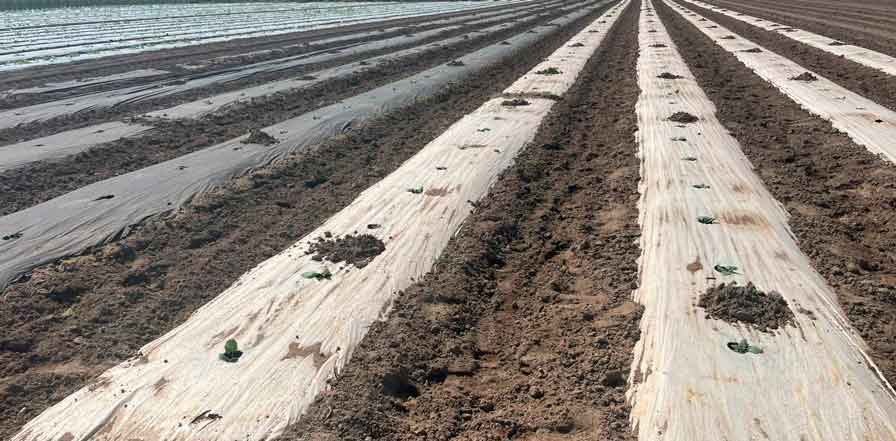
Today, paper mulch is an indispensable tool for protecting and preserving all types of crops and environments, from open fields to small spaces.
Especially if we are going to plant cabbages, due to their morphological characteristics and variable growth cycles, it is advisable to adopt sustainable ecological practices that allow us to protect the soil and the substrates we are incorporating, as well as optimize natural resources such as water, since biodegradable paper mulch stabilizes humidity and temperature levels, and is also an excellent contributor to microbial biodiversity, as it biodegrades and transforms into a wonderful nutrient for our future agricultural plans.
Furthermore, biodegradable paper mulch acts as a protective barrier for the soil and substrates by inhibiting the emergence and proliferation of weeds such as sedge and fungi, whose preferred breeding ground is uncontrolled moisture. When spread on the soil before transplanting, the mulch prevents raindrops or irrigation from splashing the structure of our cabbages with soil, reducing the possibility of fungal or bacterial infections.
By providing an effective physical defense against the germination of these competing weeds, Novamulch paper mulch reduces the need for manual weeding and eliminates the use of polluting herbicides.
Planting cabbages involves taking specific measures regarding the nature of the soil in which we will be working. We must ensure regular monitoring of our roadmap, covering everything from the conditions of the base and the root system to the superior development of our cabbages, so we can ensure we maintain continuously balanced thermal and moisture levels and an active biological structure from the beginning of planting to harvest.
Novamulch paper mulch will be our protective agent throughout all planting cycles. It also controls and maintains the ideal habitat for our crops and progressively biodegrades without leaving residues or incorporating synthetic compounds. It enriches the soil with organic carbon and promotes microbial life without altering the pH, making it suitable for certified organic farming projects as well as for conventional agricultural projects, small-scale and urban farming, and as a faithful partner for producers seeking to minimize polluting inputs and unnecessary costs.
In our cabbage planting roadmap, it’s advisable to include the use of Novamulch biodegradable paper mulch as a natural thermal regulator. Its components act as a support for the soil structure, keeping it stable and balanced, thus protecting the entire crop system and soil microbiota.
This excellent, advanced material performs continuously and in perfect condition throughout the entire growing season, and even longer, depending on its thickness and quality. As we observe its biodegradation, we can easily replace it with a new layer.
You can buy Novamulch biodegradable paper mulch here:
-
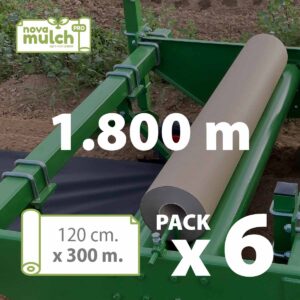 PACK of 6 rolls of Novamulch Professional paper 120 cm. x 300 m. (1.800 m)565,28 € IVA incluido
PACK of 6 rolls of Novamulch Professional paper 120 cm. x 300 m. (1.800 m)565,28 € IVA incluido -
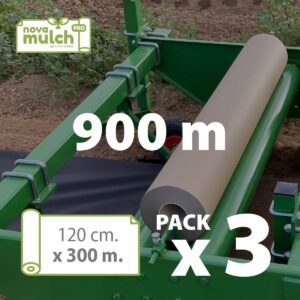 PACK of 3 rolls of Novamulch Professional paper 120 cm. x 300 m. (900 m)282,22 € IVA incluido
PACK of 3 rolls of Novamulch Professional paper 120 cm. x 300 m. (900 m)282,22 € IVA incluido -
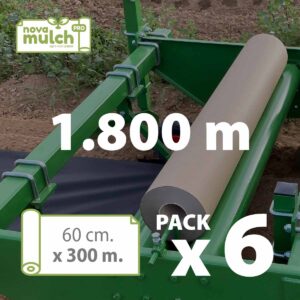 PACK of 6 rolls of Novamulch Professional paper 60 cm. x 300 m. (1.800 m)282,22 € IVA incluido
PACK of 6 rolls of Novamulch Professional paper 60 cm. x 300 m. (1.800 m)282,22 € IVA incluido -
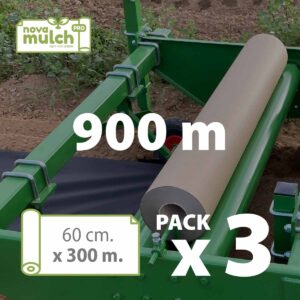 PACK of 3 rolls of Novamulch Professional paper 60 cm. x 300 m. (900 m)141,30 € IVA incluido
PACK of 3 rolls of Novamulch Professional paper 60 cm. x 300 m. (900 m)141,30 € IVA incluido -
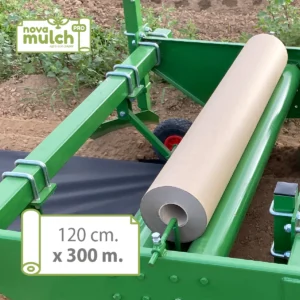 Novamulch Professional Paper 120 cm. x 300 m.94,21 € IVA incluido
Novamulch Professional Paper 120 cm. x 300 m.94,21 € IVA incluido -
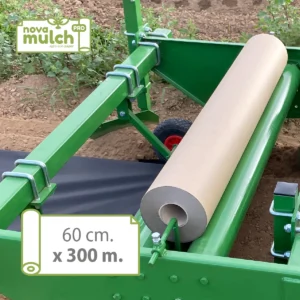 Novamulch Professional Paper 60 cm. x 300 m.47,10 € IVA incluido
Novamulch Professional Paper 60 cm. x 300 m.47,10 € IVA incluido -
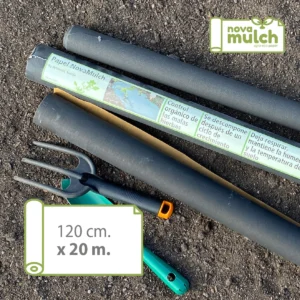 Novamulch paper 120 cm. x 20 m.41,63 € IVA incluido
Novamulch paper 120 cm. x 20 m.41,63 € IVA incluido -
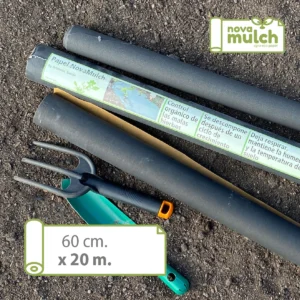 Novamulch paper 60 cm. x 20 m.21,89 € IVA incluido
Novamulch paper 60 cm. x 20 m.21,89 € IVA incluido -
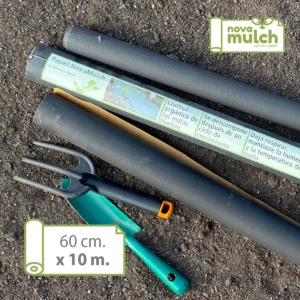 Novamulch paper 60 cm. x 10m.14,85 € IVA incluido
Novamulch paper 60 cm. x 10m.14,85 € IVA incluido -
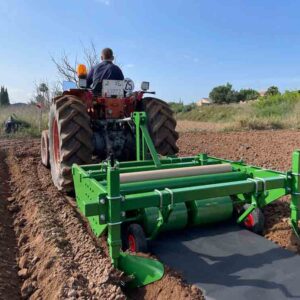 Novamulch agricultural mulching machine
Novamulch agricultural mulching machine
What ecological advantages do we gain from using Novamulch biodegradable paper mulch versus plastic mulch?
Let’s make a brief summary.
It is 100% biodegradable, compostable, leaves no polluting residue as it is made from natural cellulose fibers, and is suitable for all types of sustainable, ecological, and regenerative production, such as cabbage cultivation.
Furthermore, paper mulch respects the natural cycles of the agricultural ecosystem. It is perfectly compatible with certified organic farming practices.
It reduces dependence on petroleum-derived polymers.
By biodegrading, it increases microbial activity in the soil. Unlike plastic (which causes exudation and suffocation of the soil and root system), Novamulch paper mulch allows for proper respiration and aeration, preventing compaction and leaching, regulating humidity levels, and inhibiting the growth of weeds and fungi.
Plastic material is an excellent breeding ground for the proliferation of sedge, as it allows it to grow robustly. When it passes through the plastic material, it invades and spreads throughout our crop.
It can be installed manually or with adapted machinery, just like plastic mulch. It can be perforated or slotted to fit any growing frame. Its effective lifespan varies between 3 and 7 months, depending on the climate and irrigation.
Beneficial associations for planting cabbages.
We suggest reviewing some articles we’ve published in our Novamulch agricultural space, and we’ve presented them below to help you learn how to associate compatible plants and improve your production.
Plantar Aromáticas. Un proyecto enriquecedor con ventajas rentables todo el año.
Cómo plantar lechugas. Una oportunidad estratégica y muy rentable durante todo el año.
We’ll also add beneficial combinations such as spinach and radishes, beans and peas, and flowers like nasturtium, marigold, and borage.
Avoid planting cabbages near strawberries, tomatoes, peppers, and potatoes, as they can attract common pests that are harmful to our cabbages, deplete the soil, and compete for nutrients.
Harvest times for cabbage cultivation.
Depending on the variety, our cabbages have an estimated harvest time of between 70 and 150 days after transplanting. We’ll know the right time to harvest when we notice that the heads or buds are firm and compact to the touch. If we wait too long, the heads will open and begin the flowering or earing phase, and we’ll lose the quality of our fruit.
Storage to properly preserve cabbages.
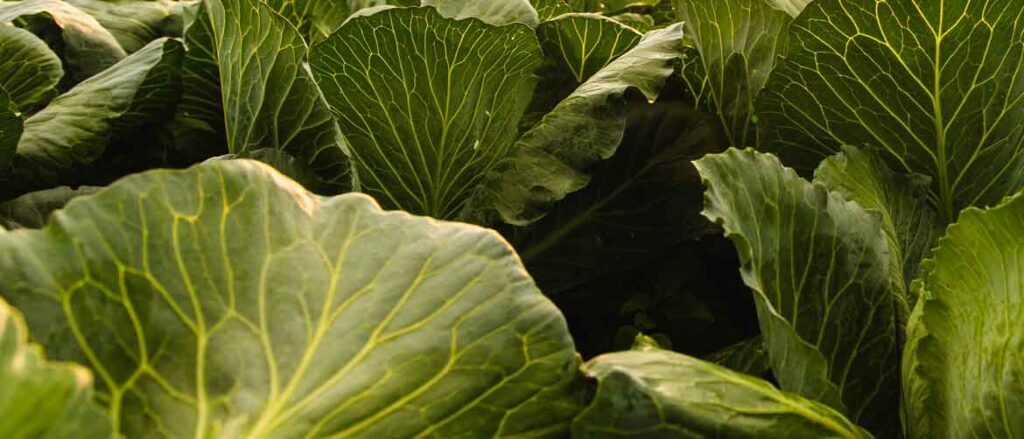
First, let’s look at fresh storage.
- First, let’s look at fresh storage.
- Relative humidity: between 90% and 95% to prevent dehydration.
- Storage time under refrigeration: estimated between 2 and 6 weeks depending on the variety. Remember that winter cabbages are best stored refrigerated.
- Recommendation: Do not wash the cabbage before storing. Keep the outer leaves that protect the head.
Storage in basements or cold rooms.
If you don’t have a refrigerator, we recommend storing cabbages in a dark, cool, and well-ventilated space. You can hang them upside down by the stem or place them on shelves, avoiding crowding them. We’ll check them periodically to remove any damaged leaves.
Long-term storage.
Long-term storage. We can preserve white cabbage in particular by fermenting it (sauerkraut); this is a traditional and healthy way to preserve it. If we need to freeze it, we can cut it into pieces or grate it, blanch it for 2 or 3 minutes, let it cool, dry it, and store it in airtight bags with ventilation holes.
Do we know what sauerkraut is?
This fermented food is part of an ancient tradition and is still very common and valued today for preserving cabbage, especially white cabbage.
During this fermentation process, natural lactic acid bacteria convert the sugars in cabbage into lactic acid, which helps preserve the food, gives it a characteristic acidic flavor, and enriches it with probiotics.
Preparation of white cabbage sauerkraut:
Grate or finely chop the fresh cabbage. Mix with salt, calculating approximately 2% of the cabbage’s weight (preferably sea salt).
In a deep container, press the juice thoroughly to remove the juice and seal it in a container with holes or vents. Place it in a cool, dark place for approximately 2 to 6 weeks to allow the fermentation gases to escape through the holes in the container.
It is well known that cabbage sauerkraut is beneficial for intestinal health and digestion, and generates vitamins C and K.
Common pests and diseases to consider before planting cabbages.
Let’s examine the common pests.
Cabbage caterpillar (Pieris brassicae and Pieris rapae).
Description: They are larvae of white butterflies and lay yellow eggs on the underside of leaves.
Damage they cause: The caterpillars feed on the foliage, leaving large holes. In severe cases, they can completely defoliate the plant.
Ecological control: Inspect and eliminate egg and caterpillar colonies, apply Bacillus thuringiensis var. kurstaki (Bt), a selective bioinsecticide, and encourage the presence of insectivorous birds and parasitoid hornets (Cotesia glomerata).
Ashy aphid (Brevicoryne brassicae).
Description: Small grayish insects that form dense colonies, especially on tender parts.
Damage they cause: They suck sap, weakening the plant. They also excrete honeydew that attracts fungi such as sooty mold.
Ecological control: Applications of potassium soap or neem oil, and introduction of natural enemies, such as ladybugs (Coccinella septempunctata) or lacewings.
Cabbage fly (Delia radicum).
Description: A small gray fly that lays eggs at the base of the stem. The larvae bore into the roots.
Damage caused: Wilting, reduced growth, and premature death. Symptoms resemble those caused by irrigation problems or soil-borne diseases.
Ecological control: Place protective collars at the base of the stem, rotate crops, remove residues after harvest, and use insect netting or fine mesh.
Leaf miner (Phytomyza rufipes).
Description: The larvae excavate visible galleries inside the leaves.
Damage caused: Leaves become discolored and lose photosynthetic capacity. They affect the plant’s overall development.
Ecological control: Remove affected leaves and encourage natural predators such as the wasp Diglyphus isaea.
Cabbage flea beetle (Phyllotreta spp.).
Description: Small, black or metallic beetles that jump like fleas.
Damage caused: They produce circular holes, especially in young seedlings.
Ecological control: Place thermal mats (tunnels or veils), and plant trap plants such as arugula around the crop.
Thrips (Thrips tabaci and Frankliniella occidentalis).
Description: Tiny, elongated insects that scrape and suck out cell contents.
Damage caused: Silvery spots on leaves, deformation, and stunted growth.
Ecological control: Introduce predatory mites (Amblyseius cucumeris) and place blue or yellow sticky traps.
Soil nematodes (Meloidogyne spp.).
Description: Microscopic, they attack roots, forming nodules or galls.
Damage they cause: Stunting, yellowing, and wilting leaves; they severely reduce yield.
Ecological control: rotation with non-host crops, use of green manures such as marigolds or mustard, which reduce the nematode load.
General integrated management recommendations for planting cabbages with optimal results: nematodes.
- Rotate crops, avoiding planting cabbage or cruciferous vegetables in the same area for at least 2 to 3 years.
- Apply natural extracts such as garlic infusion, neem tannins, nettle or horsetail.
- Keep the growing area clean and well ventilated.
- Use resistant varieties whenever possible. A good example is the Kilaton F1 variety, which is highly resistant to cabbage root rot.
Now let’s study the common diseases in cabbage cultivation.
Cabbage hernia (Plasmodiophora brassicae).
- Characteristics: Soilborne disease caused specifically by a very small microorganism that lives in humid environments. It penetrates the roots, forming galls or bumps and preventing the absorption of water and nutrients. It can cause irreversible damage to crops.
- Symptoms: Galling or swelling of roots, wilting, chlorosis and reduced growth, and plants become susceptible to water stress.
- Conditions conducive to the disease: Acidic, humid and compacted soils.
- Ecological control: Crop rotation for at least 5 years with non-cruciferous species,
- liming the soil to raise the pH to 7.0, use of resistant varieties such as Kilaton F1 or Tekila F1.
Downy mildew (Hyaloperonospora parasitica).
- Characteristics: Oomycete (fungus-like) that primarily affects seedlings and young leaves.
- Symptoms: Irregular yellow spots on the upper surface, grayish or whitish mycelium on the underside, leaf deformation and rot in humid conditions.
- Conditions conducive to the disease: High levels of humidity and cool temperatures between 10° and 20°C.
- Ecological control: adequate ventilation, especially in greenhouses and urban gardens, drip irrigation rather than sprinkler irrigation, and preventive application of horsetail extract.
Alternariosis (Alternaria brassicae and A. brassicicola).
- Characteristics: Fungal disease that affects all phases of cabbage cultivation.
- Symptoms: Blackish circular spots with concentric rings on leaves, stems and pods, premature leaf loss and necrosis.
- Conditions that promote the disease: Frequent rainfall, excessive watering, stress due to imbalance in nitrogen levels.
- Organic control: choose certified seeds, disinfect beforehand, use organic fungicides such as potassium bicarbonate or sulfur, and combine with repellent plants such as marigolds.
Black rot (Xanthomonas campestris pv. campestris).
- Characteristics: Bacteria that especially affects warm and humid climates.
- Symptoms: V-shaped yellowing from the edge towards the veins, bacterial exudates, soft tissues, unpleasant odor, may affect the vascular system causing dieback.
- Conditions conducive to the disease: High humidity, wounds, sprinkler irrigation.
- Ecological control: carry out long rotations of no less than 3 years, remove plant residues and cruciferous weeds before the crop is grown, and choose seeds treated with heat or plant biocides (cinnamon, thyme).
Cauliflower mosaic virus (CaMV).
- Characteristics: Virus transmitted by aphids, especially Brevicoryne brassicae, known as the gray cabbage aphid.
- Symptoms: Yellow-green mottling on leaves, dwarfism, deformations and reduced production.
- Ecological control: biological control of aphids with natural enemies, planting living barriers such as onions or leeks, avoiding late plantings where there is a risk of greater viral pressure.
Sclerotinia or White rot (Sclerotinia sclerotiorum).
- Characteristics: Soil fungus that produces sclerotia or resistance structures, such as sclerotia, chlamydospores (which withstand drought and extreme temperatures), dormant eggs (allowing the population to survive in the absence of cultivation), overwintering eggs (survive the winter and hatch in spring), resistance spores (survive in the soil for up to 20 years).
- Symptoms: Appearance of white cottony mycelium on stems and leaves, watery rot with black internal sclerotia.
- Conditions conducive to the disease: high humidity levels, poorly drained soils.
- Ecological control: Incorporating Trichoderma spp. into the soil, avoiding waterlogging, eradicating resistance structures by breaking their life cycles through crop rotation, soil solarization, and biofumigation.
This video is for learning how to organically prevent pests in our cabbages:
Here is a good recipe for organic insecticide:
Final thoughts.
We have analyzed in detail all the stages and processes required for planting cabbages. From their ancestral origins to the implementation of the most innovative and ecological cultivation techniques, such as biodegradable paper mulch, we are learning not only how to plant cabbages, how to sow, fertilize organically, harvest, and store them, but also how to prepare our growing habitat with ecological criteria to maintain the natural balance of the environment, how to connect with and understand the wise cycles of the earth, and how to adapt intelligently, responsibly, and creatively to every corner of the spaces that nature offers us, so that we can sow with commitment, wisdom, and abundance.

